-
Recent Posts
Recent Comments
- admin on Thank You for Confirming Your Subscription to Gluten Free Food
- melissa tefft on Thank You for Confirming Your Subscription to Gluten Free Food
- Dr.Alya Shabunin on Thank You for Confirming Your Subscription to Gluten Free Food
- admin on Celiac, Gluten Intolerant, Wheat Allergic and interested parties
- link building software on Celiac, Gluten Free Support Group meetings, events of interest
Archives
- October 2024
- September 2024
- August 2024
- July 2024
- June 2024
- May 2024
- April 2024
- March 2024
- February 2024
- January 2024
- December 2023
- November 2023
- October 2023
- September 2023
- August 2023
- July 2023
- June 2023
- May 2023
- April 2023
- March 2023
- February 2023
- May 2022
- March 2022
- February 2022
- October 2017
- September 2017
- July 2017
- May 2017
- March 2017
- February 2016
- June 2015
- March 2015
- September 2014
- May 2014
- April 2014
- March 2014
- January 2014
- September 2013
- August 2013
- July 2013
- May 2013
- March 2013
- December 2012
- April 2012
- January 2012
- September 2011
- July 2011
- May 2011
- March 2011
- February 2011
Categories
Meta
Men’s Health and Fertility and Diet
Dr. Google, men’s health and the health of their fertility is on my mind. thank you for asking. I just read a blurb about the idea, perhaps observation, of faster aging happening now. More research needs to be done for me to be comfortable with that concept. However, something is going on that in health and wellness have been talking about, without any consensus. So, let’s get into a healthy diet. The most researched one, and very successful one, is the Mediterranean Diet. The classic one, not the I will do it my way version. The real one includes social eating, i.e., with extended family and/or other company, and a non sedentary lifestyle. The proverbial three legged stool–good food, good company, physical activity. Good food is a vague description. OldwaysPT.org is a great resource to utilize. I have a bibliography I can share about Med. Diet resources as well. Ask me. When you have optimal nutrition on board your brain, heart, hormones, organs and tissues work much better, and in ways they are supposed to. Guess what else works, Duh! Plus, the old axiom of “use it or lose it” is a law of Nature too. As we said the male contributes 50% of the genetic messages to the new person involved. Why compromise that any further than the genetic material you were given, the toxic load we all have been exposed to in our modern environment, food supply, workplaces, homes, etc. Believe it or not, our homes are possibly the most toxic part of our existence. We do know about key nutrients and life style choices that have effect on the male contribution that should be taken advantage of daily. In sports medicine/nutrition we talk about the exquisite balance of nutrients an athlete needs to max performance, and that includes 80 nutrients. That’s almost the whole Periodic Table of the Elements. Food for thought. Two goals to go: Eat 30 different fruits and vegetables during the week, and forever; and call or message me so we can answer your questions and your needs. I am a chef, paramedic, long term clinical dietitian, fertility dietitian, and have some ideas…
Posted in Uncategorized
Leave a comment
Men’s Health Month-Fertility for Men
Men’s Health Month and Fertility for Men-
continuing about weight: an increase in weight above the healthy weight range (see BMI) can physically impede fertility by generating a state of excess pressure, inflammation and physical heat around male reproductive organs, particularly the testes. Excess weight can also result in hormonal imbalances. A high percentage of body fat mass causes increased estrogen and decreased testosterone levels. Low testosterone has a cascade effect which decreases libido, erectile function and impacts the quality and quantity of sperm produced. Overweight men are more likely than healthy weight men to produce immature and immobile sperm (making it difficult to reach the egg) and/or sperm that have increased DNA fragmentation (affecting the genetic makeup of the sperm).
This is serious business for something we take for granted and seems so simple. There are healthy ways to take care of this and they are not overnight solutions and take some time solve and correct. Let’s get started, message me, or call, from anywhere.
(info from Early Life Nutrition “Fertility for Men”.)_More tomorrow…
continuing about weight: an increase in weight above the healthy weight range (see BMI) can physically impede fertility by generating a state of excess pressure, inflammation and physical heat around male reproductive organs, particularly the testes. Excess weight can also result in hormonal imbalances. A high percentage of body fat mass causes increased estrogen and decreased testosterone levels. Low testosterone has a cascade effect which decreases libido, erectile function and impacts the quality and quantity of sperm produced. Overweight men are more likely than healthy weight men to produce immature and immobile sperm (making it difficult to reach the egg) and/or sperm that have increased DNA fragmentation (affecting the genetic makeup of the sperm).
This is serious business for something we take for granted and seems so simple. There are healthy ways to take care of this and they are not overnight solutions and take some time solve and correct. Let’s get started, message me, or call, from anywhere.
(info from Early Life Nutrition “Fertility for Men”.)_More tomorrow…
Posted in Uncategorized
Leave a comment
Men’s Fertility Health
Men get the attention this month, and we aren’t going to whine about being forgotten until this time next year. We don’t talk much about fertility, except for the lawn and gardens. However, none of us would be here if it wasn’t a thing. Men obviously make a 50% contribution to the genetic make up of your future baby. Nutrition now, before the egg and sperm unite, is super important. To make a difference in the outcome this has to be addressed a minimum of 3 months before, and through the pregnancy. Six months and more obviously are better. Lifestyle choices also matter. This is serious business that is mostly taken for granted or ignored. Some tidbits follow, starting with weight…
Being overweight can have a significant impact on your fertility. One study found that a 22 pound increase in male weight, above the healthy weight range, reduced fertility by 10%. This is only part of the effect. More will be addressed in tomorrow’s post. (Info contribution from “Fertility for Men” by Early Life Nutrition Alliance)
I am interested in your comments and questions, please do…
Being overweight can have a significant impact on your fertility. One study found that a 22 pound increase in male weight, above the healthy weight range, reduced fertility by 10%. This is only part of the effect. More will be addressed in tomorrow’s post. (Info contribution from “Fertility for Men” by Early Life Nutrition Alliance)
I am interested in your comments and questions, please do…
Posted in Uncategorized
Leave a comment
Men’s Health 101
This is Men’s Health Month. Here are some tidbits about a nutrient that we tend to ignore. We do so at our peril. Even in areas of the country where there is plenty of sunshine the populace is at a deficit. It has a lot of important and beneficial functions.
I am talking about the unique vitamin that many of us don’t get
enough of—vitamin D. In fact, more than 40% of American
adults have a vitamin D deficiency. It is actually a hormone.
Often called the “sunshine vitamin,” vitamin D is crucial for
maintaining bone health, boosting the immune system,
and even regulating our mood to combat depression.
But did you know that vitamin D has specific benefits for men?
Let’s dive into how this fantastic vitamin can work wonders for you.
5 Surprising Ways Vitamin D Boosts Men’s Health
1. Enhances Muscle Development
Did you know that adequate vitamin D can help speed up muscle
recovery after a tough workout?
This essential nutrient is key not only for bone health but also for
muscle strength and recovery. It helps with muscle regeneration
and maintaining mitochondrial function.
According to a study published in the Journal of the International
Society of Sports Nutrition, supplementation can significantly
decrease muscle cell damage caused by exercise.
So, think of vitamin D as your workout buddy!
2. Boosts Testosterone Levels
Vitamin D significantly impacts testosterone production,
which is essential for energy, mood, and overall vitality in men.
Research, including a 2011 study, has shown that supplementation
can increase testosterone levels in overweight men who are
trying to lose weight.
Additionally, there’s evidence that men with erectile dysfunction
often have deficiencies in this nutrient. Improving your vitamin D
levels could help enhance testosterone levels, thereby improving
sexual health.
A simple blood test can determine your vitamin D levels,
and your healthcare provider can recommend the right dosage
to improve erectile function. So, don’t be shy – get checked!
3. Helps Boost Fertility
Who would have thought optimal vitamin D levels are essential
for male fertility? Studies have found positive associations
between vitamin D levels and sperm count and motility. Men contribute 50% to the pregnancy journey. Their health and lifestyle choices can make a huge difference in outcome, as with infertility due to their questionable choices. As a Certified Fertility Dietitian I can assist with better choices for success.
A study from 2021 found that supplementation helped
boost sperm motility in men with low vitamin D levels.
It’s like giving your little swimmers a power-up!
4. Regulated Mood and Mental Health
Did you know that boosting your vitamin D could help improve
your mood and decrease symptoms of depression?
Low levels of this nutrient have been linked to depression.
Studies have shown that boosting vitamin D levels can improve
symptoms of depression. A 2014 review found that taking a
vitamin D supplement had similar effects to taking an antidepressant.
5. Hair Growth
While more research is needed, there’s some indication that
vitamin D may play a role in hair follicle health.
Low levels of vitamin D are associated with hair loss,
suggesting that maintaining adequate levels could help
with hair growth.
So, if you’re noticing more hair in the shower drain,
it might be time to check your vitamin D levels.
Getting Enough Vitamin D
fun fact
If you’re wondering how to up your vitamin D game, you can find it in foods like fatty fish (salmon, trout, tuna, mackerel), egg yolks, and fortified foods such as cereal, milk, and orange juice.
Soaking up some sunlight is another great way to boost your vitamin D levels. Just 10-30 minutes of midday sunlight several times a week can help your body produce this essential vitamin.
However, factors like location, skin type, and sunscreen use can affect this, making dietary sources and supplements important too.
Supplementing with Vitamin D
Considering that it can be challenging to get enough vitamin D
from food and sunlight alone, taking vitamin D supplements or
multis with vitamin D in it can be a great option.
The recommended daily allowance (RDA) for adults is 600 IU per day, but some experts suggest that 1500-2000 IU per day may be more beneficial.
Want to know more, how to test and when, how much to take, and more, message me or call.
I am talking about the unique vitamin that many of us don’t get
enough of—vitamin D. In fact, more than 40% of American
adults have a vitamin D deficiency. It is actually a hormone.
Often called the “sunshine vitamin,” vitamin D is crucial for
maintaining bone health, boosting the immune system,
and even regulating our mood to combat depression.
But did you know that vitamin D has specific benefits for men?
Let’s dive into how this fantastic vitamin can work wonders for you.
5 Surprising Ways Vitamin D Boosts Men’s Health
1. Enhances Muscle Development
Did you know that adequate vitamin D can help speed up muscle
recovery after a tough workout?
This essential nutrient is key not only for bone health but also for
muscle strength and recovery. It helps with muscle regeneration
and maintaining mitochondrial function.
According to a study published in the Journal of the International
Society of Sports Nutrition, supplementation can significantly
decrease muscle cell damage caused by exercise.
So, think of vitamin D as your workout buddy!
2. Boosts Testosterone Levels
Vitamin D significantly impacts testosterone production,
which is essential for energy, mood, and overall vitality in men.
Research, including a 2011 study, has shown that supplementation
can increase testosterone levels in overweight men who are
trying to lose weight.
Additionally, there’s evidence that men with erectile dysfunction
often have deficiencies in this nutrient. Improving your vitamin D
levels could help enhance testosterone levels, thereby improving
sexual health.
A simple blood test can determine your vitamin D levels,
and your healthcare provider can recommend the right dosage
to improve erectile function. So, don’t be shy – get checked!
3. Helps Boost Fertility
Who would have thought optimal vitamin D levels are essential
for male fertility? Studies have found positive associations
between vitamin D levels and sperm count and motility. Men contribute 50% to the pregnancy journey. Their health and lifestyle choices can make a huge difference in outcome, as with infertility due to their questionable choices. As a Certified Fertility Dietitian I can assist with better choices for success.
A study from 2021 found that supplementation helped
boost sperm motility in men with low vitamin D levels.
It’s like giving your little swimmers a power-up!
4. Regulated Mood and Mental Health
Did you know that boosting your vitamin D could help improve
your mood and decrease symptoms of depression?
Low levels of this nutrient have been linked to depression.
Studies have shown that boosting vitamin D levels can improve
symptoms of depression. A 2014 review found that taking a
vitamin D supplement had similar effects to taking an antidepressant.
5. Hair Growth
While more research is needed, there’s some indication that
vitamin D may play a role in hair follicle health.
Low levels of vitamin D are associated with hair loss,
suggesting that maintaining adequate levels could help
with hair growth.
So, if you’re noticing more hair in the shower drain,
it might be time to check your vitamin D levels.
Getting Enough Vitamin D
fun fact
If you’re wondering how to up your vitamin D game, you can find it in foods like fatty fish (salmon, trout, tuna, mackerel), egg yolks, and fortified foods such as cereal, milk, and orange juice.
Soaking up some sunlight is another great way to boost your vitamin D levels. Just 10-30 minutes of midday sunlight several times a week can help your body produce this essential vitamin.
However, factors like location, skin type, and sunscreen use can affect this, making dietary sources and supplements important too.
Supplementing with Vitamin D
Considering that it can be challenging to get enough vitamin D
from food and sunlight alone, taking vitamin D supplements or
multis with vitamin D in it can be a great option.
The recommended daily allowance (RDA) for adults is 600 IU per day, but some experts suggest that 1500-2000 IU per day may be more beneficial.
Want to know more, how to test and when, how much to take, and more, message me or call.
Posted in Uncategorized
Leave a comment
Got healthy brain function?
“Enjoying a high quality of life as you get older means taking care of your brain as much as your body. And research suggests that what you eat today will help (or hurt) your cognitive abilities later.” (dementia marches on, insidiously, and possibly for 50% of us, and we can prevent it). Mostly this is from an intro to “The Mind Diet”, a very important tome, by Maggie Moon. This. and Peter Attia’s book “Outlive” should be well hilited and acted upon by all of us, or, certainly, our caretakers.
Posted in Uncategorized
Leave a comment
Womens health with the Fertility dietitian
We are winding down with the Fertility Dietitian course. Next week is the exam. Then we are set loose as Certified Fertility Dietitians. With what I have witnessed in the last few years as a health care practitioner with the troubles many people have in child bearing and afterward, there is a lot that can be done with some nutrition support, tweaks with some choices in foods, supplements, and lifestyle. We have known for some time that 95% of women of child bearing age are nutritionally deficient. Why? We also know by some recent publications that all but one product, out of 20,000 products examined, used as possible prenatal multiple vitamin/mineral combinations were also deficient, if not completely bad choices. This is where practitioner knowledge can be very helpful. The one product that passed the test is one that we have been offering for over …let’s just say since we got married. Our consistent branding partner, who now can legally say they are the most clinically proven wellness company in the world. We all benefit by that quality, safety and efficacy. Last year they launched a very well thought out Prenatal and thru the first 1000 days Nutritional Program that changes through each stage of the prenatal, each trimester, and post natal into the baby’s 2nd year. We can utilize a computer guided program to help in decision making-it has over a million data points, and we can utilize the info from the program I am completing-PCOS. endometriosis, adenomyosis, miscarriage, other complications. The men aren’t forgotten either, they are 50 % contributors to the intended outcome-the healthy baby. There is a lot to it and we are here to be of help. You can help by telling your friends, and we have no geographical boundaries.
Posted in Uncategorized
Leave a comment
Women’s Health hacks
Holistic Strategies for Healthy Aging
🌸One thing is for sure: we ALL age and want to stay healthy as we do!
Did you know that decreased estrogen levels in aging make women more vulnerable to certain health issues?
· Heart disease is the #1 KILLER of women who are more at risk after menopause.
· Bone loss occurs gradually from age 30
· 80% of osteoporosis occurs in women (especially after menopause)
But here’s the good news! There are evidence-based things you can do to help keep your heart strong and your bones resilient. 💪
Keeping Your Heart Healthy ❤️
· Stay Physically Active. Try to do something active every day––take the stairs, go for a walk at lunch, take a dance class, or ride your bike. Remember to do strength training during the week.
· Focus on Heart-Healthy Foods. Enjoy veggies, lean protein (such as fish, poultry, beans, and nuts), fruits, whole grains, and healthy fats. Limit trans fats, sodium, and added sugars.
· Manage Stress. From breathing practices and meditation apps to time in nature or with your favorite people, cultivate a de-stress habit.***
· Know Your Numbers. Work with your provider to track your blood pressure and monitor your cholesterol and triglyceride levels. Follow Dr. Peter Attia’s info in Outlive. there are specific tests you need.
· Aim for a Healthy Weight. You can lower your heart disease risk by keeping a healthy weight. Heart-healthy eating and staying physically active will help with this. BMI is best between 19 to 25. Above 25 often indicates insulin resistance and inflammation, with short and long term negative outcomes.
· Try Helpful Supplements. Blood Pressure by Shaklee is a scientifically supported nutritional solution to help retain healthy blood pressure.* Other important nutrients are VitaLea-multi vite/mineral, Omegaguard for EPA/DHA, Vivix-a Resveratrol combination*. There are many others, ask me for assistance in learning what may be of benefit. We have an interesting computer assist with millions of data points, as well.
Protecting Your Bone Health🤸🏽♀️
· Engage in Weight-Bearing and Strength-Building Exercises. Strengthening your muscles supports your bones! You can do this through weight-bearing movement like walking, dancing, and stair climbing plus any exercise that builds strength.
· Do Balance and Coordination Practices. Movement practices like yoga, qigong, and dance can help reduce your risk of falls and fractures.
· Keep a Healthy Weight. Being underweight or overweight can increase your risk of bone loss and fractures.
· Get Enough Calcium and Vitamin D. Aim for 1200mg/day from all calcium sources, plus 800 -1,000 IU (20 – 25mcg) of vitamin D3. OsteoMatrix® contains these and other nutrients to help minimize bone loss.* Have your vitamin D tested twice a year to learn if your levels are optimal. Most people aren’t optimal.
· Avoid Smoking and Excessive Alcohol. Tobacco use and over drinking may result in a lower bone mass, increasing your risk of fractures.
🧠 Bonus Tip: Some women report increased forgetfulness during perimenopause or early menopause. MindWorks® and omega-3 supplements like OmegaGuard® may be helpful here. MindWorks ingredients have been clinically shown to improve your mental sharpness and focus, with vital nutrients to help keep your brain healthy as you age.* The DHA in OmegaGuard helps support healthy brain function.*
Remember––aging may bring changes, but you get to keep your sparkle! ✨
➡️ What do you hope to enjoy doing more of as you get older? I want to ________.
*These statements have not been evaluated by the Food and Drug Administration. This product is not intended to diagnose, treat, cure, or prevent any disease.
www.heart.org to learn about the difference between symptoms in women and men. They can be significant, and often missed in women. Learn CPR, that knowledge led to a miracle in my family and a life saved. It helped me save my neighbor across the street. You never know. I did CPR on a man on a train platform in Oslo. He survived. The skill set is worth the time and effort, and do the refreshers on a timely basis.
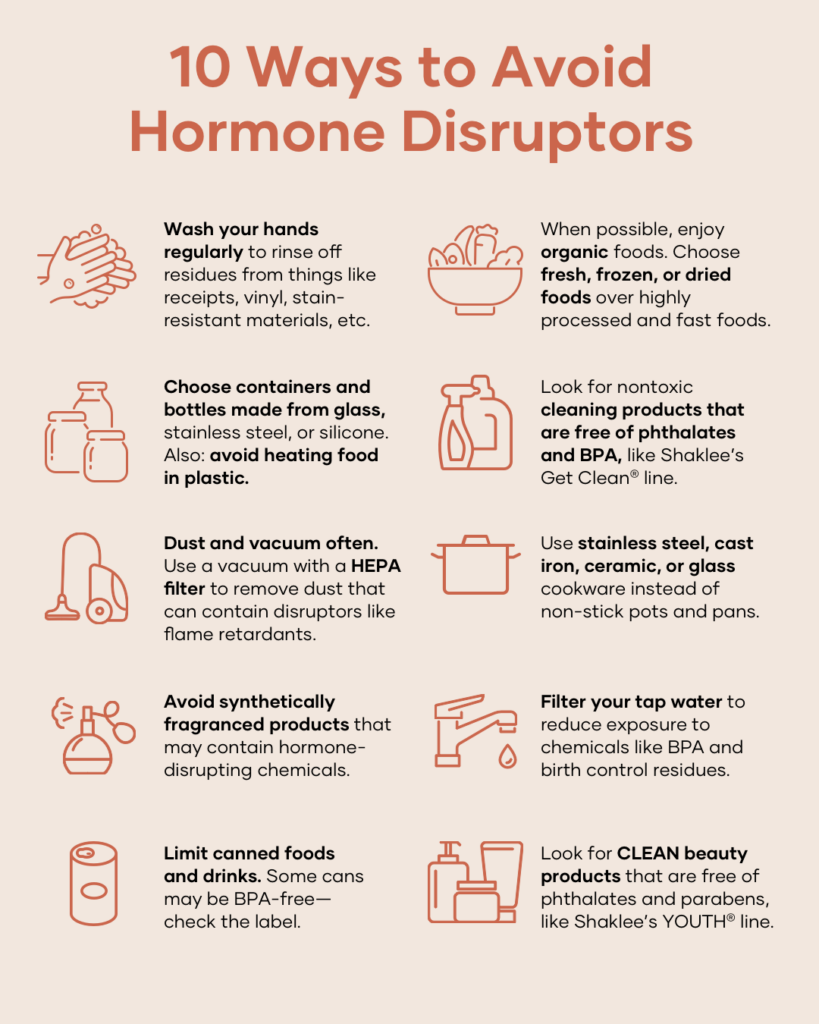
Posted in Uncategorized
Leave a comment
Womens wellness and NEAT
NEAT for Women’s Health
We talked about how exercise benefits women’s health, but did you know there is another type of movement that helps you burn extra calories and stay healthy?
It’s called NEAT (Non-Exercise Activity Thermogenesis), and studies suggest it’s the most important factor to predict whether you lose weight and keep it off! One large study found that people with higher levels of NEAT experienced less cardiovascular disease and a lower mortality rate. REGARDLESS of how much intentional exercise they were doing.* 🤯
So, what is NEAT? It’s basically all movement that isn’t intentional exercise. In other words, things like gardening, standing, walking to the store, cooking, cleaning, and taking the stairs.
People who move throughout the day are more likely to achieve weight-loss goals than those who have one intense exercise session but are sedentary the rest of the day. Crazy, right? Even small increases in your NEAT activity can burn hundreds of daily calories. 🔥
Check out the graphic below for ways to increase your NEAT.
🤔 How would you like to ramp up your NEAT activity? Comment below what your favorite NEAT activities are. Do you have a favorite that’s not on this list?
*Source: https://pubmed.ncbi.nlm.nih.gov/24167194
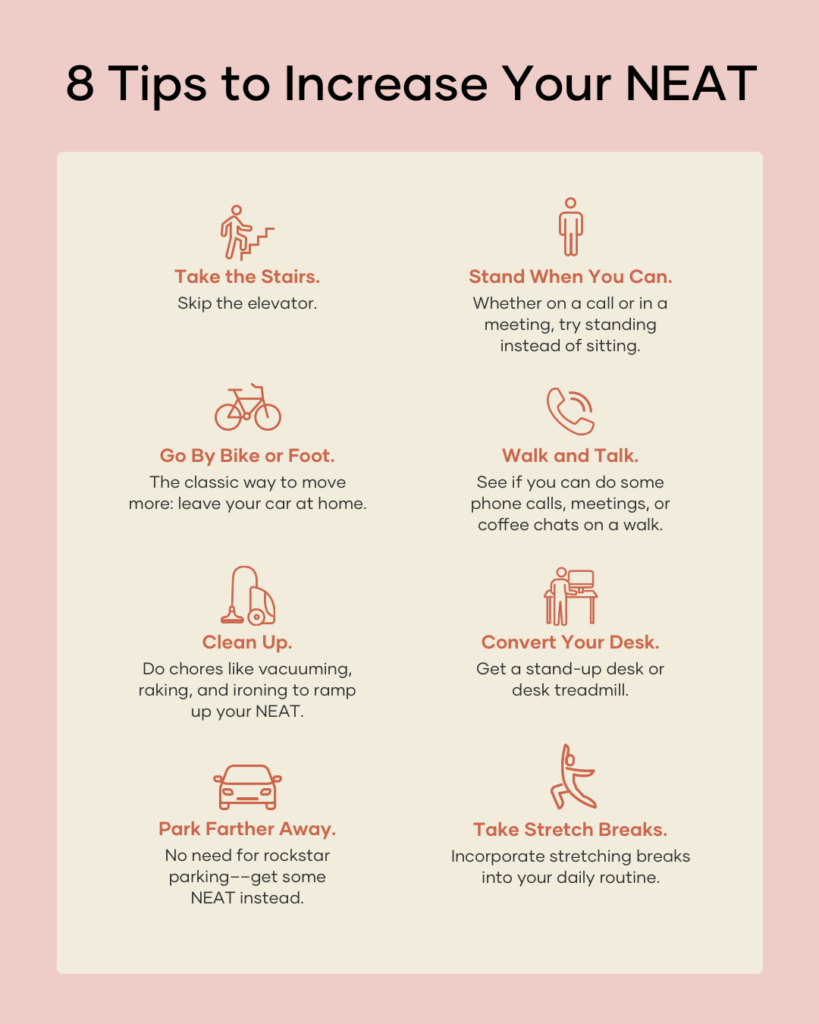
Posted in Uncategorized
Leave a comment
Women’s Health in Stages
NUTRITION FOR WOMEN’S HEALTH BALANCE 😊
Taking care of our health as women starts with how we nourish ourselves. 💖 Let’s kick today off with the basics of nutrition tailored for US.
🥗 Nutrition 101 for Women of all Life Stages
· Focus on the balanced basics. Keep it simple by filling your plate with whole foods, including fruits, veggies, whole grains, healthy fats, and lean proteins. These foods give you nutrients that are essential to your health. Most women don’t eat the recommended 5 servings a day of fruits and veggies––which are packed with nutrients, fiber, and antioxidants.
· Optimize with super foods for women. There are good reasons we have berries, cruciferous veggies, beans, whole grains, and omega-3-rich foods on our Trackers. Watch for our next post, where we’ll explore these foods and more!
· Limit the ultra-processed stuff. Limiting sugar supports healthy hormone levels by helping to support healthy blood sugar levels. Highly processed foods are problematic because they’re typically low in fiber and nutrients and high in fat, added sugar, or salt.
· Fill any nutrient gaps with a high-quality multivitamin supplement. Make sure you have your nutrient bases covered. We love Shaklee Vita-Lea®, Vitalizer™, or Meology® supplements for this.
·
🍽️ Women’s Special Nutrition Needs by Life Stage
· Young Adult through Peri-menopause
At this stage, you are losing iron with each menstrual cycle, so getting enough iron is key. Aim for the RDA of 18 mg of iron a day. Building and maintaining healthy bones is crucial during young adulthood to prevent osteoporosis later in life. A balanced diet rich in calcium and vitamin D helps support bone health.
· Prenatal + Pregnancy + Breastfeeding
Nutrition plays a vital role throughout pregnancy and breastfeeding, providing critical nutrients for both you and your baby. These needs are so specific that we’ve created the pregnancy nutrition info graphic below.
· Postpartum
With a new baby at home, your body is working overtime to recover from pregnancy and produce breast milk. You have several important nutritional needs, which we outlined in the postpartum info graphic below.
· Menopause + Post-Menopause
After menopause, lower estrogen levels make you less able to retain calcium and more vulnerable to losing bone mass. Calcium, magnesium, and vitamin D become extra important to help prevent osteoporosis and your calcium RDA increases to 1300 mg. To limit age-related muscle loss, you also want to support your muscles with a protein-rich diet. Heart-healthy choices like berries and fiber-rich foods are essential at this time as well. Stay tuned for more on bone and heart health in a later post!
➡️ What nutritional supplements are you taking these days? Are you thinking about adding any? See us on Wellness 360 – #GenH and scroll through to see the many resources available to you.
*These statements have not been evaluated by the Food and Drug Administration. This product is not intended to diagnose, treat, cure, or prevent any disease.
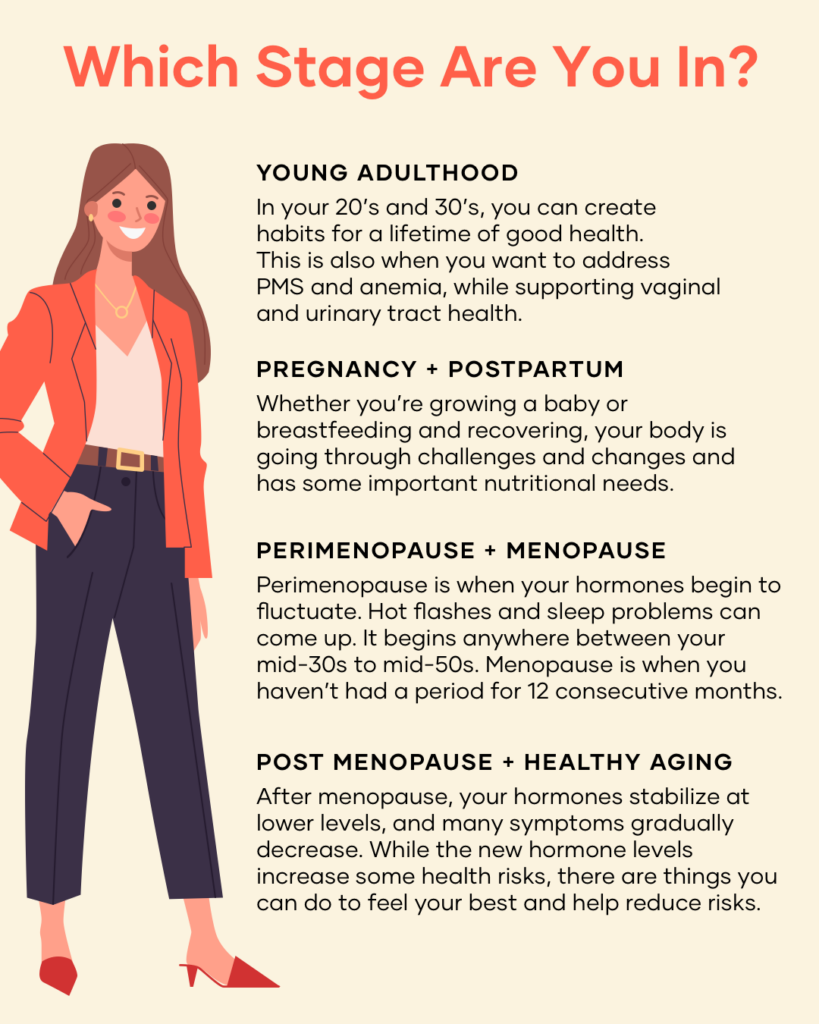
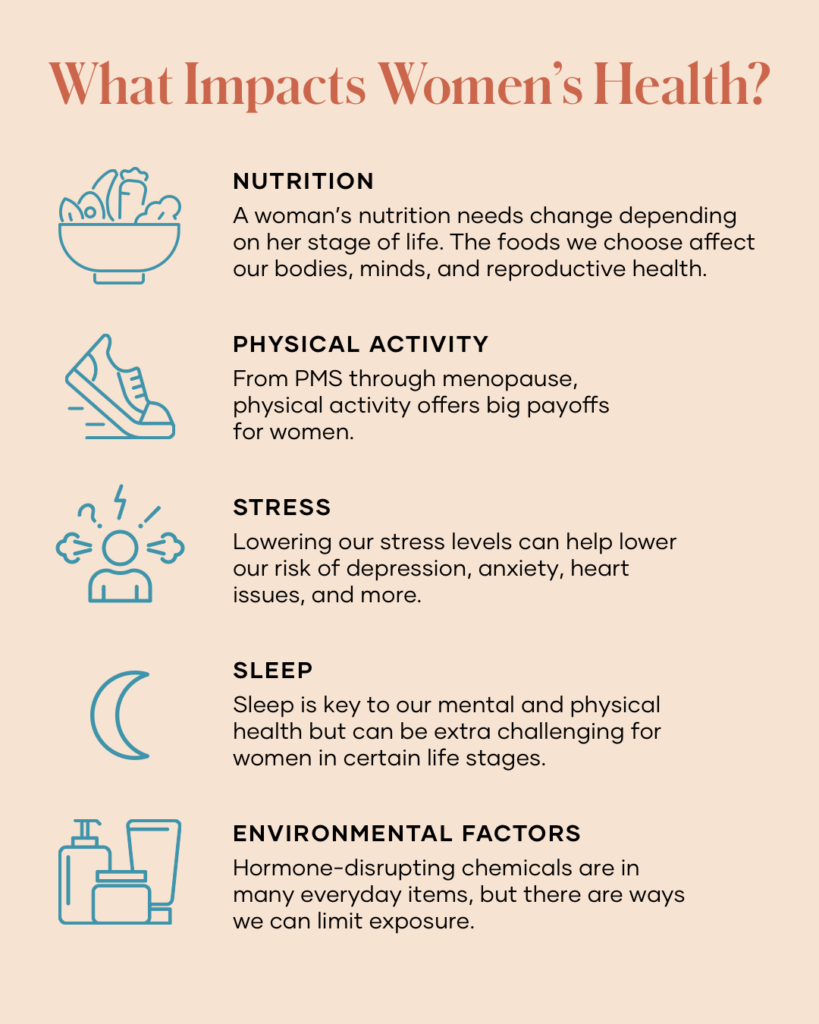
Posted in Uncategorized
Leave a comment
Women’s Wellness Challenge
We are excited to start this 6-Day Women’s Wellness Challenge with you tomorrow! Taking care of ourselves starts right here. 🙌
As women know, bodies change a lot throughout our lifetime. We’re going to talk about support for all women at every age, as well as tips for specific stages––from young adulthood to pregnancy to post-menopause. Each stage has unique needs.
Empower and support each other to nurture our health as women, no matter what stage. Who’s ready?! ✋ 💃 Here are the details of our group Challenge.
🌿 The 6-Day Challenge (starting tomorrow!)
You’ll soon learn how each of these habits supports women’s health. We think you’ll feel pretty great if you do these for a week!
Track these habits with your Habit Tracker each day:
• Move for 30 minutes
• 15-min destressing practice (reading, yoga, meditation, etc.)
• Eat women’s health superfoods:
o 1 serving of berries
o 1+ servings of cruciferous veggies
o 1+ servings of whole grains or beans
o 1+ servings of omega-3 DHA/EPA foods (or supplement)
• Take your supplements
• Get 7+ hours of sleep
Even if you can’t participate fully with the Challenge, stick around! We’ve got lots to share. 🔬
The Shaklee science team has helped prepare some great evidence-based content for all of us.
How to participate:
1. 📝 Fill out your daily Habit Tracker each day. (Save the Tracker below and check it off digitally OR print the PDF version from the Files tab.)
2. 📲 Post your Tracker in the comments section of our daily Check-In post.
3. 💬 Join the discussion! Share your tips and recipes in the comments––we want to see!
4. 🎁 Win free prizes! Be entered into our raffles by posting your Tracker, commenting on our posts, and sharing with the group. The more you participate, the more chance you have of winning.
5. 🎉 Have fun! Invite a friend! We are Wellness 360 – #GenH, on facebook, come on in and scroll through to see many resources.
➡ Let us get to know you! Below, tell us your name, where you’re from, and why you joined this group.
——
https://www.womenshealth.gov/hea…/healthy-eating-and-women
In addition to other nutrients, seafood has two important omega-3 fatty acids: eicosapentaenoic acid and docosahexaenoic acid, more
commonly called EPA and DHA. These fatty acids may affect:12,13
Risk for heart disease
Risk for preterm birth (also called premature birth)
Growth and development in unborn babies and breastfed infants
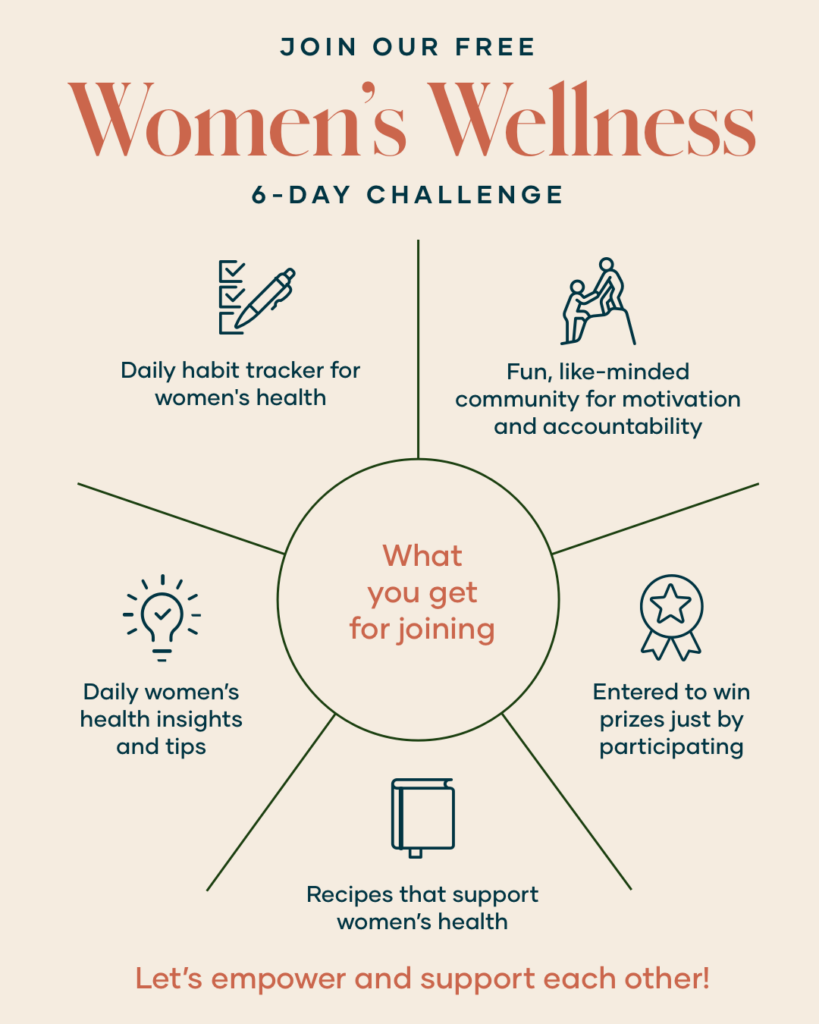
Posted in Uncategorized
Leave a comment
